IN THE NAME OF GOD, THE MOST GRACIOUS, THE MOST MERCIFUL
This blog is dedicated to the work we produced for Islamic Architecture, an elective subject done in Taylor's University. In this subject, we are going to analyse the relationship of the seven principles in Islamic Architecture throughout prominent Islamic period. In the first project, myself in a group of 3 should complete a research and analysis about the architecture during the prophet Muhammad S.A.W, Khalifah Al-Rashidin until the Umayyad period. The second project is to gather informations about the Tabung Haji Tower and the relation with the Islamic Architecture principles.
PROJECT 1 : RESEARCH TIMELINE ANALYSIS
After separating task between group members, my part is to gather information from the prophet Muhammad S.A.W. until the expansions done by the rest of the Khalifah. The research started by identifying the place which the research will take place, which is Makkah and Medina which both located in Saudi Arabia. The two prominent building that will be analysed is Masjidil Haram, Masjidil Nabawi and Masjidil Aqsa.
MASJIDIL HARAM
The small cubed building known as the Kaba may not rival skyscrapers in height or mansions in width, but its impact on history and human beings is unmatched.
The Kaba is the building towards which Muslims face five times a day. This has been the case since the time of Prophet Muhammad S.A.W. over 1460 years ago.
The very first construction of the Kaba was done by Prophet Adam (PBUH). Allah says in the Quran that this was the first house that was built for humanity to worship Allah.
Next was Prophet Ibrahim and Ismail (PBUH) rebuilt the Kaba. The measurements of the Kaba's Ibrahimic foundation are as follows:
- The eastern wall was 48 feet and 6 inches
- The Hateem side wall was 33 feet
- The side between the black stone and the Yemeni corner was 30 feet
- The Western side was 46.5 feet
Following this, there were several constructions before the Prophet Muhammad S.A.W. time.
Makkah during 470M
Reconstruction of Kaba by the Quraish clan
Prophet Muhammad S.A.W. participated in one of its reconstructions before he became a Prophet. After a flash flood, the Kaba was damaged and its walls cracked. It needed rebuilding. This responsibility was divided among the Quraish's four tribes. Prophet Muhammad S.A.W. helped with this reconstruction. Once the walls were erected, it was time to place the Black Stone (Hajar ul Aswad) on the eastern wall of the Kaba.
Arguments erupted about who would have the honor of putting the Black Stone in its place. A fight was about to break out over the issue, when Abu Umayyah, Makkah's oldest man, proposed that the first man to enter the gate of the mosque the following morning would decide on the matter. That man was the Prophet. He came to them and the asked him to decide on the matter. He agreed.
Prophet Muhammad proposed a solution that all agreed to - putting the Black Stone on a cloak, the elders of each of the clans held on to one edge of the cloak and carried the stone to its place. The prophet then picked up the stone and placed it on the wall of the Kaba.
Since the tribe of Quraish did not have sufficient funds, this reconstruction did not include the entire foundation of the Kaba as built by Prophet Ibrahim. This is the first time the Kaba acquired the cubical shape it has now unlike the rectangled shape which it had earlier. The portion of the Kaba left out it called Hateem now.
The development of Masjidil Haram
The relation with Seven principles of Islamic Architecture


Masjidil Nabawi
Introduction
The Prophet's Mosque, generally considered Islam's holiest site after the Kaaba, is built at the site of Muhammad's ancient home in Yathrib (modern-day Medina, Saudi Arabia). Muhammad performed much of the labor on the original mosque himself, and the present-day mosque still contains his tomb, which is located beneath the Green Dome. It also holds the tombs of early Islam caliphs, 'Umar and Abu Bakr
The History
Not long after Muhammad's move to Yathrib (now known as Medina) in 622 CE, he and his followers built a small mosque adjacent to the Prophet's home in which they could worship and conduct prayers. The original structure measured approximately thirty by thirty-five meters, and was built from palm trunks and mud. A pulpit was built in the mosque so that Muhammad could speak to his followers and conduct prayer. Across the courtyard from the pulpit there was a covered area where his followers could find shade. Many Islamic mosques are patterned after this original layout.
As the number of Muslims grew, the Prophet's Mosque was enlarged to accommodate the growth. In 706, the original structure was torn down under the direction of the Islamic caliph al-Walid so that a larger mosque could be built in its place. This new mosque incorporated the site of Muhammad's home and the tomb of Muhammad himself, making the Prophet's Mosque the second holiest site in Islam.
The Prophet's Mosque has undergone numerous renovations and expansions over the centuries, and it is currently one of the largest mosques in the world. Stone columns, elegant decoration, and modern conveniences such as air conditioning and escalators have replaced the original palm trunks and mud. The mosque also has a second floor and roof with movable domes, making it possible for over 500,000 people to worship together.
The relation with seven principles of Islamic Architecture
Masjidil Aqsa
Al-Aqsa mosque
Al-Aqsa ("the farthest") mosque is located on the southern side of the temple mount, and is the 3rd most holiest site in Islam. It is named after the Muslim's account of the night travel of prophet Muhammad to the remote mosque.
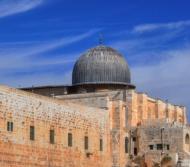
Overview:
Al-Aqsa ("the farthest") Mosque is located on the southern side of the temple mount, and is the 3rd most holiest site in Islam. Initially built in 705 AD, the present silver-dome structure dates to 1035AD. It is named after the Muslim's account of the night travel of prophet Muhammad, who according to their tradition was transported from Mecca to Jerusalem.
Location:
The mosque is located on the southern edge of the Temple Mount. It is accessed from the temple mount for Muslims, or through the nearby Mugrabi gate for other faiths during regulated hours between the prayers.
History of the place:
- Biblical period
According to some scholars, during the 10th C BC this was the location of King Solomon's "house of the forest of Lebanon", as described in the Bible (Kings 7 1-7): "...He built also the house of the forest of Lebanon".
- Roman Period
The area of the al-Aqsa mosque was part of the great second temple which was built in 20BC by Herod the Great, King of Israel under the Romans (37BC - 4BC). After the Romans crushed the great revolt (70AD), the temple was leveled and was in ruins until the end of the Byzantine period.
- Arab period
The Arabs conquered Jerusalem in 638AD, and Khalif Omar visited and prayed in the site in that year. The dome of theRock shrine, with the large golden dome and an octagon structure, was built by the Umayyad Khalif Abdul-Malik ibn Marwan in 691 (72 year according to Muslim calendar), and named it after Omar. It is one of the most beautiful and enduring shrines in the World, and remained almost untouched throughout the years. The rock is, according to Muslim tradition, the spot where prophet Mohamed ascended to heaven.
Years later, either in 696 (by the same Khalif) or in 705AD (by his son), another dome was built on the far south side: the Al-Aqsa mosque (also "Al-Aksa", which means "the remote" mosque). It was named after the tradition of prophet Muhammad's imaginative night travel from Mecca to a remote mosque (Qur'an Night Journey 17 1): "Glory be to Him Who made His servant to go on a night from the Sacred Mosque to the remote mosque of which We have blessed the precincts, so that We may show to him some of Our signs; surely He is the Hearing, the Seeing".
After the mosque was destroyed in the great earthquake of 749, it was repaired by 780. Following another devastating earthquake (1033) it was rebuilt (1035), which is the present day structure.
- Crusaders
In 1099 the Crusaders called the Temple mount as "Templum Domini", turned the Dome of the rock to a church, adding a cross on the dome. They turned the Al-Aqsa mosque to a prayer house and then to Baldwin's royal palace in 1104, naming it King Solomon's palace.
The Templar Knights military-religious organization was established in 1118, and named their organization after the temple. The vast halls under Al-Aqsa mosque was believed to be King Solomon's stables, a name still used today in the area that the was cleared under the mosque.
The Crusaders were driven out from Jerusalem by Saladin in 1187.
- Modern Years
The Dome of the Rock shrine and the al-Aqsa mosque remain active until today. In 1967 Israel reunited Jerusalem, but left the control of the temple mount to the Muslim Wakf. From time to time there are religious and political frictions ignited at the site, for example the riots in year 2000 that sparked the 5-years Palestinian uprising, called the "Al-Aqsa Intefada". The situation seems explosive almost periodically, and the Israeli police staffs thousands of policemen in some Fridays, limiting the age and residence of the allowed persons to enter the temple mount in order to reduce the friction. There are some extreme Jewish groups who want to rebuild the "third temple", but this is a small group which is limited by the authorities. In addition, there are political debates over the fate of the city, which spells out more trouble in this hot spot.
Plan:
The figure illustrates the plan of the southern side of the temple mount, indicating the major sites. The Al-Aqsa mosque is in the center of the south wall, and is capped by a silver dome.
After entering the main entrance on the north side, there is a large colonnaded praying hall.
The mosque's southern side is attached to the temple mount south wall. A prayer niche - Mihrab - is installed on the south wall, directed towards the Islam Holy cities of Mecca and Medina.
On the west side of the mosque is a women's prayer all, a Mugrabi mosque, and the Islamic Museum.
On the east side of the mosque is a large open area, with underground halls named "Solomon's stables".
| 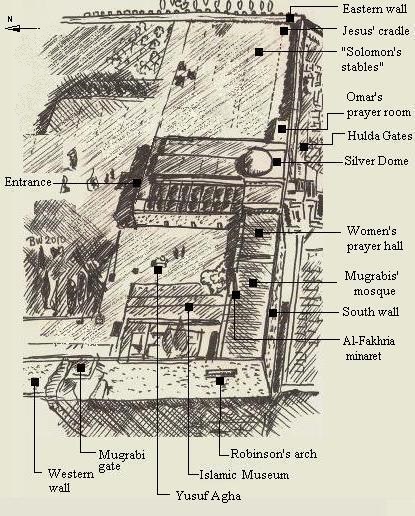 |
Photos:
(a) General View
The south-west side of the temple-mount is seen in the photo below. The Al-Aqsa mosque, with its silver dome, is located on the southern wall.
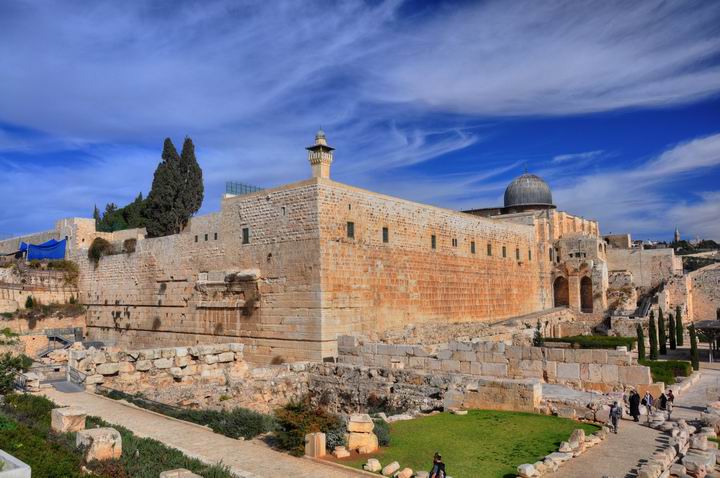
The photos are organized in the order from west to east.
(b) Museum
The Islamic museum is located on the western side of the Al-Aqsa. It was established in 1923 and transferred to this location in 1927.
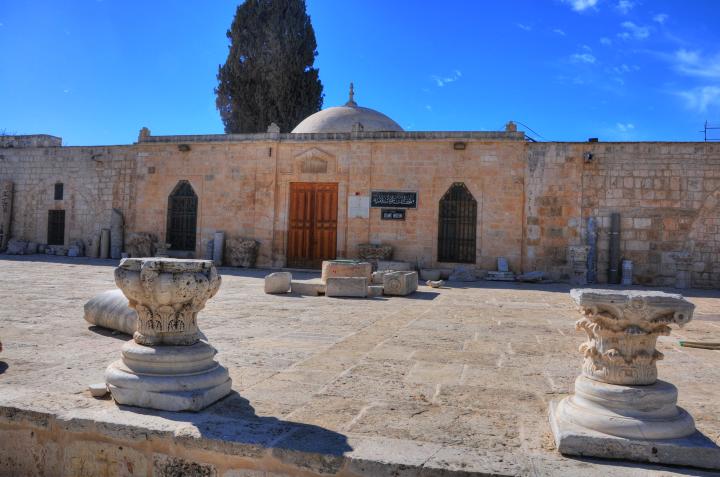
Corinthian capitals are on display in the yard between the museum and the Al-Aqsa mosque.
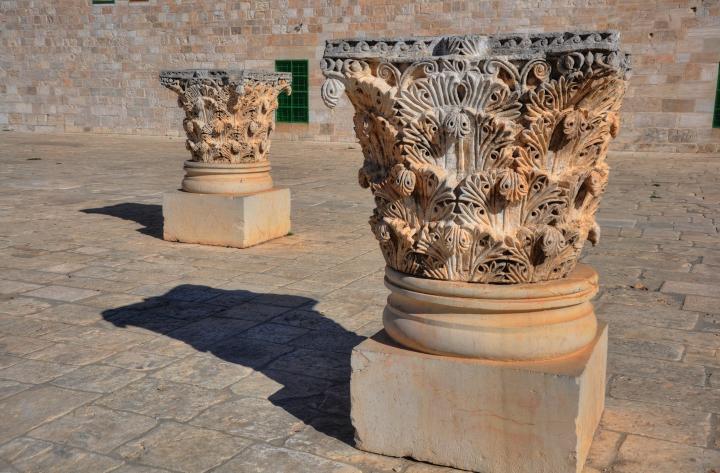
(c) Minaret
A tower, the Al-Fakhria minaret, is located on the south-west corner of the temple mount. The minaret tower (from Arabic: Manara =lighthouse) is a distinctive architectural feature of an Islamic mosque, and used for calling for prayers and a visual landmark. The temple mount has a total of four minarets - al-Fakhria (this tower), Bab al-Asbat (on the north-side overlooking Bethesda), al-Ghawanmeh (on the north-west side) and Bab al-Silsilah (on western wall).
Marble columns and other archaeological items, part of the Museum, are on display along the walls.
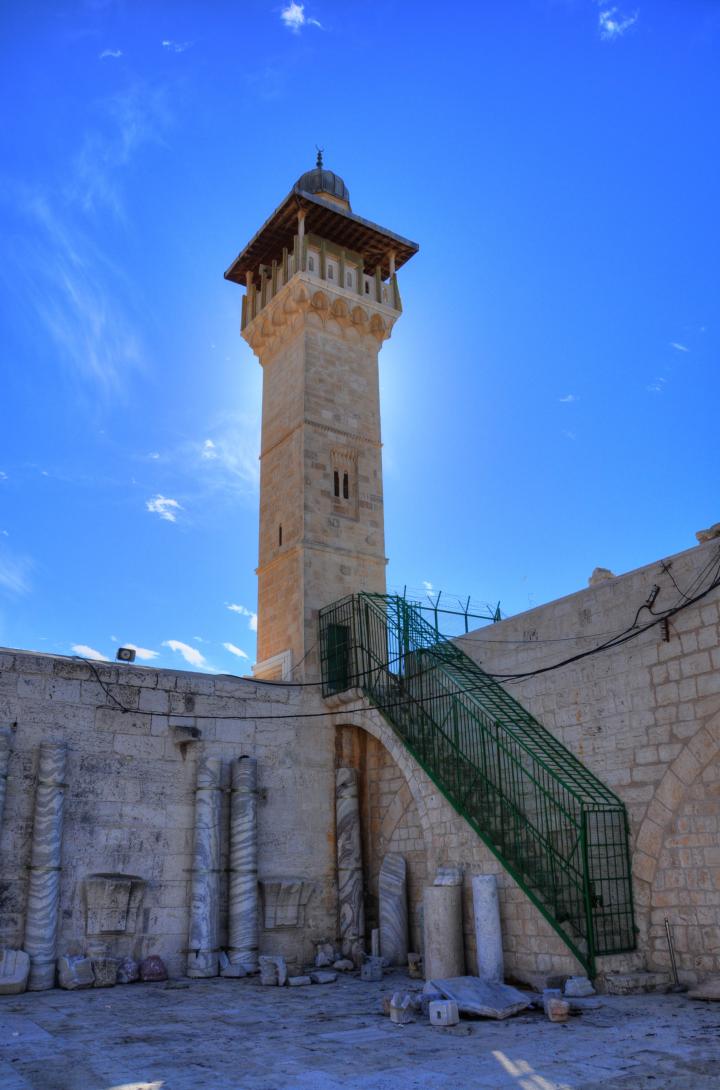
(d) Western side of Al-aqsa
Inside the temple mount, on the western side of the Al-Aqsa mosque, is the court yard of the Islamic museum and the mosque of the Mugrabis (westerners).
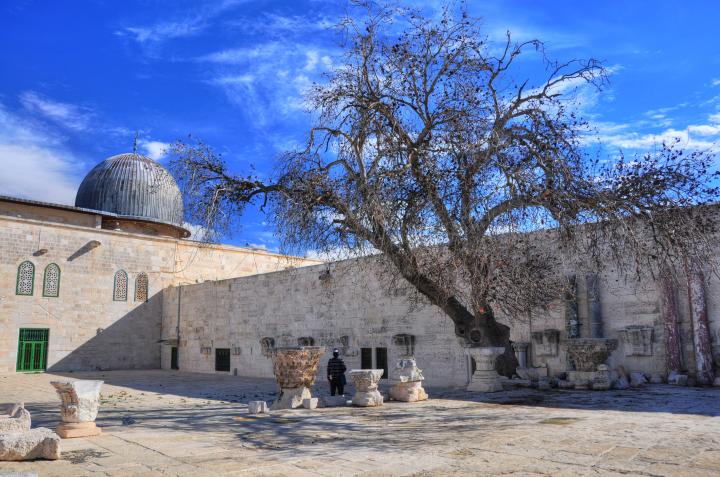
Another view of the western side of the mosque is seen in the following picture. The small structure in the center of the courtyard is called the dome of Yusuf Agha, a small (5m x 5m) structure which was erected in the 17th C by Yusuf, the Ottoman Chief Eunuch (term 1671-1687).
(e) North side
The entrance to the mosque is from the north side. To enter into the prayer hall the shoes must be taken off and stored in the wooden box.
Another view of the entrance to the mosque is shown in the following picture.
To the north of the mosque (37m from the entrance) is a small fountain - El-Kas ("the Cup"). It was built by the Mameluke governor of Damascus in 1320, and served the worshippers. The water was fed from an aqueduct that supplied water to the temple, based on the Jerusalem "lower aqueduct" that delivered water to the city in the Roman period, from Solomon's pools (near Bethlehem) to the temple mount (20KM in total length).
The following photo shows the fountain, the golden Dome of Rock behind its right side, and the "prophet's olive tree" behind its left side.
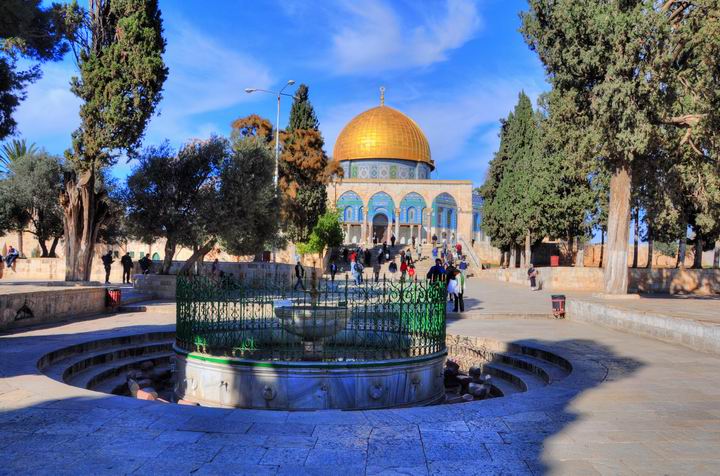
(f) Light Show
In June 2010, as part of the Jerusalem Light Festival, the Al-Aqsa mosque and the southern walls were illuminated with a special illumination:
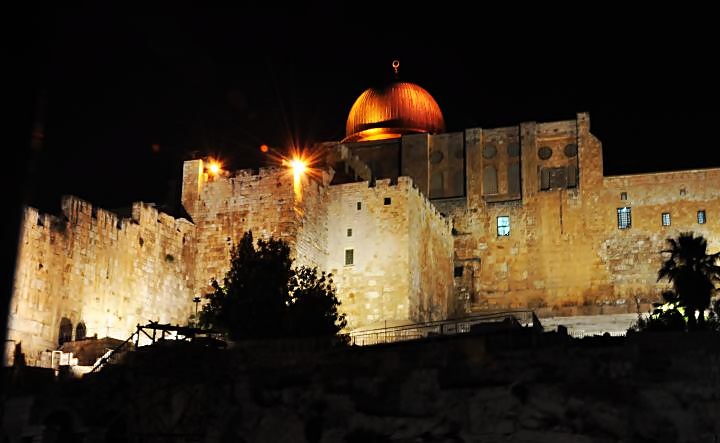
Etymology (behind the name):
|
The Story Of The Isra and Miraj
Following the ‘Year of Sorrow’, a dark time for the early Muslims, Prophet Muhammad (PBUH) experienced the Isra (the Night Journey) and the Miraj (the Ascension). A journey that begun at the Kaaba in the city of Makkah that went to Masjid Al-Aqsa in the city of Jerusalem, and concluded in the Heavens.
The Angel Gabriel (Jibreel) used to come to Muhammad (PBUH) often, but on a special night, the Angel came to him and told him to circumambulate the Kaaba seven times. At the Kaaba, Jibreel told him that he would be going to Al-Aqsa Mosque on the Buraq, where they would then ascend to the Seventh Heaven to meet God, Allah (Swt).
Once at the Al-Aqsa Mosque in Jerusalem, Muhammad (PBUH) saw previous Prophets such as Abraham (Ibrahim), Moses (Musa), Jesus (Isa) and other Prophets (PBUT) and he then led them in prayer. Going to Al-Aqsa Mosque, was an indication that leadership of the world had moved to the new international Message, Islam. Allah (Swt) also wanted Muslims to realise and deeply appreciate the relation between His Sacred House and Al-Aqsa Mosque as well as reaffirming and strengthening Muhammad (PBUH) on his Mission.
The Angel Gabriel then led him from the place we now call the Dome of the Rock to the Heavens.

The Miraj (The Ascension)
In his ascension to the Heavens beyond the domain of earthly space and time, he met other Prophets (PBUT) who received him with good tidings and reassured him of his Prophethood. Muhammad (PBUH) also received the command to perform the five daily prayers by Allah (Swt) Himself.
Muhammad (PBUH)’s experience was otherworldly. Muhammad (PBUH) said to His Companions that he saw in Heaven what no eyes have seen and what no ears have heard, and what never crossed the minds of humankind. Truly, his experience was mystical and of Divine nature.
The magnificent story of the Isra and the Miraj still lives on today. Every year Muslims around the world remember the day and spend the majority (or all) of the night remembering this other-worldly and unique experience and coming closer to Allah (Swt) like Muhammad (PBUH) once did.
The relation with seven principles of Islamic Architecture
LIST OF REFERENCES
http://www.blessedislam.com/islam/the-story-of-isra-and-miraj
http://www.faithology.com/places/al-masjid-al-nabawi
http://republicofrumi.blogspot.com/2010_04_01_archive.html
http://filteryourmind.blogspot.com/2011/10/mystery-bodies-in-dome-of-masjid-nabawi.html
http://www.nbbmuseum.be/2006/11/islam.htm
http://www.panoramio.com/photo/16847999
http://www.hajinformation.com/main/f203.htm
http://yousufbawany.wordpress.com/tag/kirigami/
http://www.flickr.com/photos/batoolnasir/5613822270/in/set-72157626118247555
http://elsakrisanti.multiply.com/journal?&show_interstitial=1&u=%2Fjournal
http://downloadfotogratis.com/gambar-pintu-di-masjidil-haram.html
http://www.saatchionline.com/art/Photography-C-Type-Masjid-al-Haram-Mecca-Ouarzazate-2011/295248/136528/view
http://www.mybabyahmad.com/
http://www.almoltaqa.ps/english/showthread.php?t=10850
http://www.atlastours.net/holyland/al_aqsa_mosque.html
http://photos8.org/architecture_g30-al_aqsa_mosque_stained_glass_window_p6168.htmlhttp://www.biblewalks.com/Sites/AlAqsa.html
PROJECT 2 : CASE STUDY (ISLAMIC ARCHITECTURE BUILDINGS)
In this assignment, our group chose the Tabung Haji Tower (LUTH) in which we are going to analyze its relation with the seven principles of Islamic Architecture.
Introduction
This high-rise office tower (151.83 metres) is the headquarters of Lembaga Tabung Haji. It is the Malaysian hajj pilgrims fund board which facilitates savings for the pilgrimage to Makkah through investment in Shariah-compliant vehicles. The fund board was established in 1962 as a modest proposal to aid the Malayan rural economy and to enable the Muslims to perform 'Hajj', one of the tenets of their faith, today LUTH is one of the greatest cooperative success stories in Malaysia. Its basic principles, structured by Royal Professor Ungku Aziz who was then an economics lecturer and who later became the Vice Chancellor of the University Malaya, remain unchanged, but the institution has developed beyond imagination.The Tabung Haji Tower was completed in 1984. It was designed by the legendary Malaysian architect Hijjas Kasturi. The building back then was not only the tallest building in Malaysia but was also hailed as the highest Muslim edifice of the world. The building has a circular ground plan which flares at both its base and top, and is supported on five massive columns which line the entire height of the structure. Each column, in its hollow, includes a peripheral air conditioning system serving one fifth of each floor area. The building's forecourt is punctuated by the mosque's tapering dome surmounted by a round blue-colored finial and by a free-standing minaret ending in a blue colored pointed finial.
The Visit
After driving down to KL to visit the building, we reached the tower in time before it starts raining. After parking our car round the circular driveway, we head down to G-Tower building to get something that Taylor's students are familiar with, SUBWAY'S. After lunch, we met with the security in charge for permission to wander and take pictures. Our visit are welcomed with open hands. We were sent up to meet Hj. Mohammad Naser Jaffar, the Manager in charge of Group Public Affairs and Corporate Communication. He pretty much helped us in getting the information needed to accomplish the task.
The Presentation Slide
LIST OF REFERENCES
http://wikimapia.org/14902/Menara-Tabung-Haji
(A) http://www.hijjaskasturi.com, 2006
(B) Menara Tabung Haji brochure, May, 1984
(C) Kuala Lumpur : Renegotiating Urban Space in Malaysia, Ross King,
2008
(D) Razan Ahmad Hashim, 2012
(E) Syed Izzat, 2012


























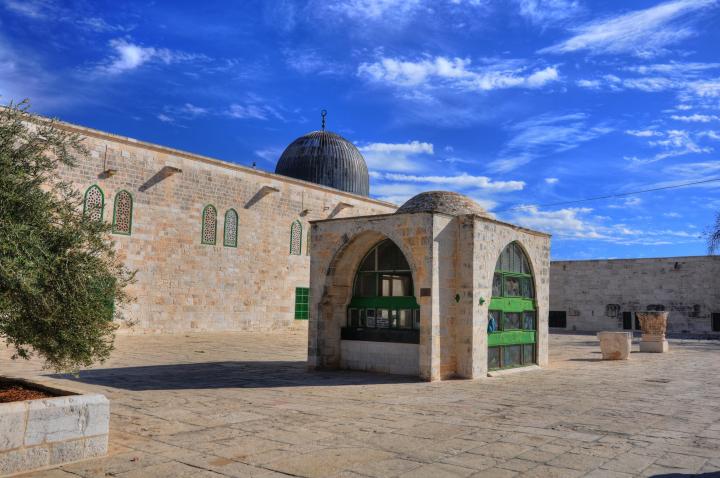
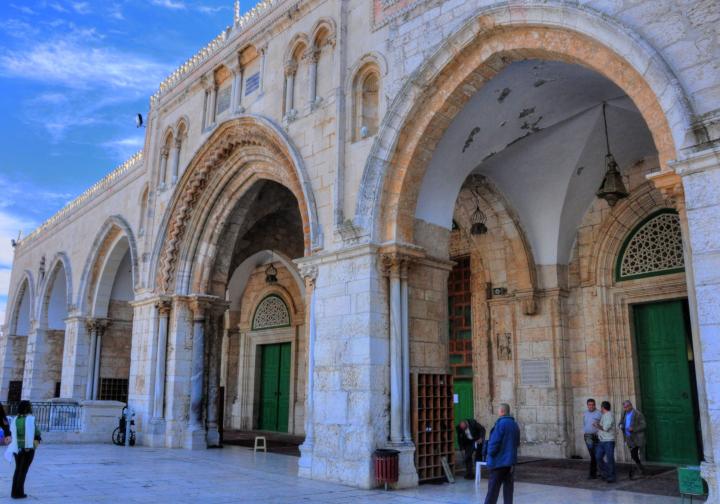
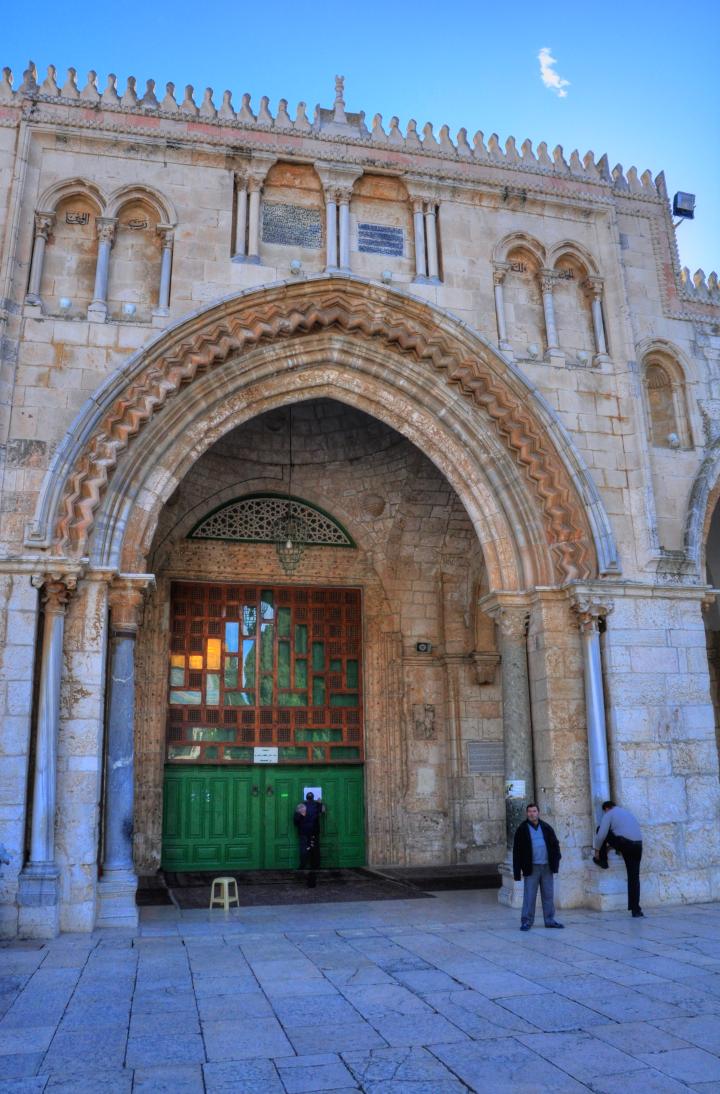





























No comments:
Post a Comment